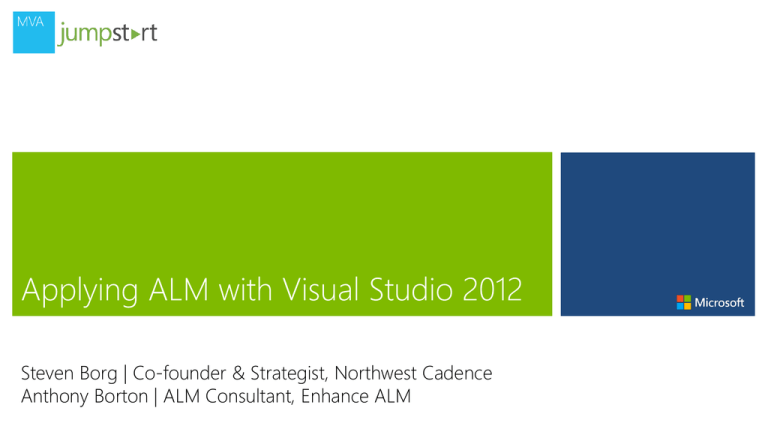
Steven Borg | Co-founder & Strategist, Northwest Cadence
Anthony Borton | ALM Consultant, Enhance ALM
Meet Steven Borg | @stevenborg
• Co-founder & Strategist, Northwest Cadence
– Specialize in helping organizations adopt lean-agile
– Prefer TFS 2012 as my end-to-end ALM tool of choice
• Background
– Microsoft ALM MVP since 2005
– Written Kanban and Scrum courseware
– Implemented Kanban and Scrum world-wide
– Many years as a Microsoft Certified Trainer
Meet Anthony Borton | @anthonyborton
• ALM Consultant, Enhance ALM
– Specialize in helping organizations adopt TFS
– Developed TFS 2010 & 2012 curriculums
• Background
– MCT (since ’96), MCP (since ’93)
– Completed 58 Microsoft exams (incl. 001)
– Australia’s first Professional Scrum Developer trainer
Course Topics
1.
Introduction
2.
Exam Overview
3.
Define an Effective End-to-End Software Development Lifecycle
4.
Define the ALM Process
5.
Define a Software Iteration
6.
Define End Value for the Software Iteration
7.
Develop Customer Value with High Quality
8.
Integrate Development and Operations
9.
Wrap up
Setting Expectations
• Target Audience
– IT Professionals that help streamline activities across all roles and
throughout the entire development life cycle
– IT Professionals studying to take to 70-498 exam
• Suggested Prerequisites/Supporting Material
– While specific Application Lifecycle Management (ALM) experience is
not required, the audience should be proficient with Application
Lifecycle Management (ALM), Visual Studio 2012 and should have
worked on a software development team.
Join the MVA Community!
• Microsoft Virtual Academy
– Free online learning tailored for IT Pros and Developers
– Over 1M registered users
– Up-to-date, relevant training on variety of Microsoft products
• “Earn while you learn!”
– Get 50 MVA Points for this event!
– Visit http://aka.ms/MVA-Voucher
– Enter this code: ALM498 (expires 6/1/2013)
©2013 Microsoft Corporation. All rights reserved. Microsoft, Windows, Office, Azure, System Center, Dynamics and other product names are or may be registered trademarks and/or trademarks in the
U.S. and/or other countries. The information herein is for informational purposes only and represents the current view of Microsoft Corporation as of the date of this presentation. Because Microsoft
must respond to changing market conditions, it should not be interpreted to be a commitment on the part of Microsoft, and Microsoft cannot guarantee the accuracy of any information provided after
the date of this presentation. MICROSOFT MAKES NO WARRANTIES, EXPRESS, IMPLIED OR STATUTORY, AS TO THE INFORMATION IN THIS PRESENTATION.
01 | Exam Overview
Anthony Borton | ALM Consultant, Enhance ALM
Steven Borg | Co-founder & Strategist, Northwest Cadence
Module Overview
• Certification Overview
• 70-498 Exam Summary
• Skills being measured
Microsoft
Virtual
Academy
Certification Overview
Path to MCSD: Application Lifecycle Management
+
=
+
More information http://examcr.am/XFRXnR
IMPORTANT: Please make sure
there’s a section transition slide in
the right places—very important for
making this a recording…!
Microsoft
Virtual
Academy
Exam 70-498 Summary
Exam details
Audience Profile
• Candidates for this exam typically use Microsoft Visual Studio
2012 to keep their teams focused on customer value and to
structure their organizations to deliver quality software
frequently and reliably.
• These candidates inspect and help streamline activities across all
roles and throughout the entire development life cycle.
Audience Profile
• The qualified candidate typically has:
– a strong understanding of current process improvement practices.
– a strong understanding of popular software development life cycle
(SDLC) methodologies, including Scrum, Kanban, and Capability
Maturity Model Integration (CMMI), as well as umbrella practices such
as Agile and Lean.
– high-level technical experience with Microsoft tools used to improve
software development effectiveness.
Microsoft
Virtual
Academy
Skills Being Measured
Breakdown of key topic areas
Integrate Development and
Operations
Develop Customer Value with
High Quality
Define End Value for the
Software Iteration
Define an Effective End-to-End
Software Development
Lifecycle (SDLC)
Role of different ALM processes
Define a Software Iteration
Define an Effective End-to-End Software
Development Lifecycle (SDLC) (17%)
• Understand the value of an end-to-end view of Application
Lifecycle Management (ALM) tools and practices
• Explain the benefits of fast feedback
• Implement strategies to reduce end-to-end cycle time
• Implement strategies to improve software quality
• Implement strategies to reduce waste
• Create a process improvement plan
Define the ALM Process (16%)
• Role of different ALM processes
• Implement a Scrum/Agile process
• Define a Scrum/Agile process for a team
• Implement Microsoft Solution Framework (MSF) for CMMI
Process Improvement
Define a Software Iteration (16%)
• Plan a release
• Define project-tracking process
• Scope a project
Define End Value for the Software Iteration (17%)
• Elicit requirements
• Estimate requirements
• Document requirements
• Prioritize requirements
Develop Customer Value with High Quality (17%)
• Define code quality indicators
• Incorporate unit testing
• Develop code
• Validate quality
• Customize a team project
Integrate Development and Operations (17%)
• Implement an automated deployment process
• Implement pre-production environments
• Manage feedback between development and operations
• Troubleshoot production issues
©2013 Microsoft Corporation. All rights reserved. Microsoft, Windows, Office, Azure, System Center, Dynamics and other product names are or may be registered trademarks and/or trademarks in the
U.S. and/or other countries. The information herein is for informational purposes only and represents the current view of Microsoft Corporation as of the date of this presentation. Because Microsoft
must respond to changing market conditions, it should not be interpreted to be a commitment on the part of Microsoft, and Microsoft cannot guarantee the accuracy of any information provided after
the date of this presentation. MICROSOFT MAKES NO WARRANTIES, EXPRESS, IMPLIED OR STATUTORY, AS TO THE INFORMATION IN THIS PRESENTATION.





